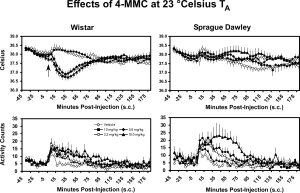The following has been published:
Wright, Jr, M.J., Angrish, D., Aarde, S.M., Barlow, D.J., Buczynski, M.W., Creehan, K.M., Vandewater, S.A., Parsons, L.H., Houseknecht, K.L., Dickerson, T.J. and Taffe, M.A. Effect of ambient temperature on the thermoregulatory and locomotor stimulant effects of 4-methylmethcathinone in Wistar and Sprague-Dawley rats, PLoS ONE, 2012, 7(8):e44652 [ OpenAccess ]
This paper describes our initial study on the thermoregulatory and locomotor effects of 4-methylmethcathinone, even though it will appear in publication after a second study focused on ambient temperature extremes. In this current study, two strains of rats were monitored (with radiotelemetry implants) for changes in body temperature and home cage ambulatory activity after the administration of 4-methylmethcathinone (4-MMC or mephedrone). The study was conducted at 23°C and 27°C ambient temperature for reasons described in the prior post.
 The main finding was that 4-MMC (1.0-10 mg/kg, s.c.) caused a dose-dependent decrease in body temperature in Wistar rats. This effect was not seen in the Sprague-Dawley rats. Effects in each strain were consistent across the two ambient temperature conditions, which was slightly surprising given prior literature with MDMA. We expected that 4-MMC would increase body temperature at 27°C.
The main finding was that 4-MMC (1.0-10 mg/kg, s.c.) caused a dose-dependent decrease in body temperature in Wistar rats. This effect was not seen in the Sprague-Dawley rats. Effects in each strain were consistent across the two ambient temperature conditions, which was slightly surprising given prior literature with MDMA. We expected that 4-MMC would increase body temperature at 27°C.
Locomotor activity was dose-dependently increased by 4-MMC in both strains with slightly greater stimulation in the Sprague-Dawley animals. A followup experiment showed that the maximum locomotor increase produced by 4-MMC at the highest dose was similar to that produced by 1.0 mg/kg methamphetamine. There was no sign of the locomotor suppression / stereotyped behavior induction observed after 5.6 mg/kg methamphetamine with any of the tested doses of 4-MMC.
A microdialysis study was conducted to evaluate the neurochemical profile of 4-MMC since no data were available when we started the study. We found relatively greater accumulation of serotonin relative to dopamine in the nucleus accumbens after the 10 mg/kg, s.c., dose used in the telemetry studies. These findings are consistent with two recent papers, one from Baumann et al (2012) and one from Kehr et al (2011) although those studies used a more restricted dose range. This neurochemical profile is much like that produced by MDMA and is different from methamphetamine or amphetamine which have a greater effect on nucleus accumbens dopamine vs serotonin.
 The strain difference in thermoregulation was unexpected and set us off on some additional work included in this paper. First, we showed with the serotonin 1A/7 agonist 8-OH-DPAT that the Sprague-Dawley and Wistar rats were equivalently responsive to hyperthermia induced by this compound. Second, we included some pharmacokinetic studies which identified only a small difference between rat strains…unlikely to explain the strain differences in thermoregulation.
The strain difference in thermoregulation was unexpected and set us off on some additional work included in this paper. First, we showed with the serotonin 1A/7 agonist 8-OH-DPAT that the Sprague-Dawley and Wistar rats were equivalently responsive to hyperthermia induced by this compound. Second, we included some pharmacokinetic studies which identified only a small difference between rat strains…unlikely to explain the strain differences in thermoregulation.
As mentioned above, we also did a followup study in a separate group of Sprague-Dawley rats in which the ambient temperature conditions were more extreme, 20°C and 30°C. In that case, hypothermia was produced at the lower ambient temperature and there was no evidence of hyperthermia at the highest ambient temperature.
Between these two papers we now conclude that the thermoregulatory properties of 4-MMC differ from those of MDMA to the extent that warmer ambient temperature does not result in 4-MMC causing hyperthermia. Thus on this particular measure of drug risk, these data support a conclusion that 4-MMC is less likely to cause thermoregulatory distress compared with the risks of MDMA.
[…] control in the Wright et al 2012 paper focused on the activity of the cathinone mephedrone [blog post summary]. To further complicate matters, the response of male Wistar rats to 8-OH-DPAT seemed to be […]
Pingback by Cannabidiol by vapor inhalation in rats | TL neuro — July 19, 2019 @ 2:38 pm